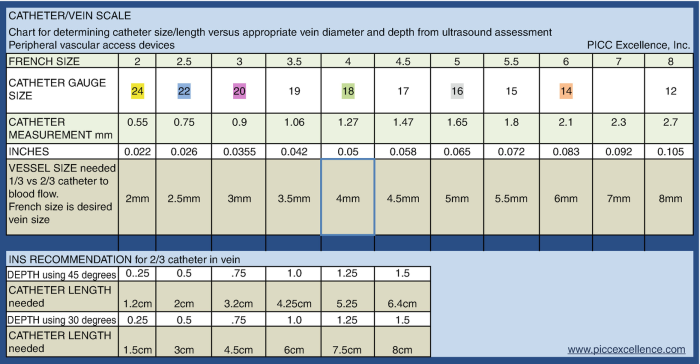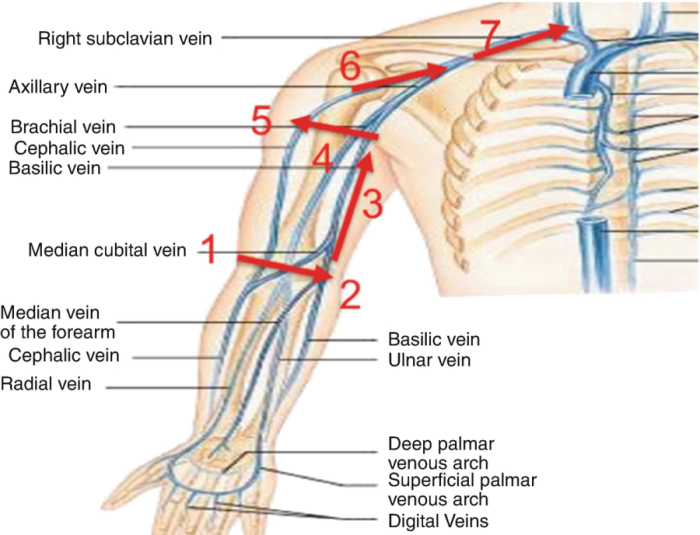
Do not use pending review by. Document the PICC dressing change clinical assessment of site and external measurement length.

Compare the measurement obtained with the preinsertion measurements for the line.
Picc line measurement documentation. At our facility - we place the Solo Power PICC. The catheter is 55cm per the hash marks on the PICC and documentation on the product label. Some of our nurses are documenting the length of the PICC at 56 cm measuring from the end of the PICC to the valve on the PICC.
I dont think we should not be documenting the 1 cm that is behind the zero mark. PICC Peripherally Inserted Central Catheter Removal-ActionRationale 05102013lm Page 3 immediately and monitor the patient for any signs of distress. If distress noted call 911 See Emergency Measures below.
Compare the measurement obtained with the preinsertion measurements for the line. Heat Apply TN PRN Apply to Line Site Place heat to PICC Line insertion site 3-4 times daily if site becomes red tender or swollen. Measure Circumference TN Qday Of.
Arm Measure PICC arm circumference midway between elbow and axilla Qday for first 3 days after insertion. No BP or Venipunctures TN in PICC Line arm. Measurement of external catheter and arm circumference per facility policy.
Inspect surrounding skin for edema breakdown irritation etc. Perform hand hygiene Open PICCCentral line dressing change kit andor supplies using sterile technique Don sterile gloves per protocol. Gently remove the dressing from the PICC line insertion site.
Hold the external PICC line and find the notch marks running along the thinnest part of the tube. These are placed 1 cm apart. Count and record the number of exposed notch marks.
If the tube does not have notches use a tape measure to assess the length of the external tubing. External length of picc documentation Does anyone have a policy regarding the floor nurses having to document daily in their assessments the external length of a PICC. I have only found literature stating that the external length is documented at the time of insertion and when the dressing is changed by the staff nurse or IV nurse.
PICC Line or Midline Catheter Dressing Change Purpose. To prevent external infection of the peripheral or central venous catheter Frequency. Assess the dressing in the first 24 hours change for accumulation of blood fluid or moisture beneath the dressing.
After the first 24 hours the frequency is every seven days. If we wanted to document the external length for some reason the external length of the catheter in this instance would be 4cm. If someone else then instead measures to the hub theres usually only about 1 1 12 cm extra not enough to make a difference trying to figure out if it has migrated or not.
If there is a lot of concern about 1cm. Central and PICC Lines Care and Best Practices Mary Larson SN St. Cloud State University Nursing Program.
December 21st Capstone Semester Preceptor. Jamie Daniel 180 Direct Patient Care Hours 90 Leadership Hours 40 at Meeker Memorial Leadership Project- Teaching. Anyways my hospital has a really big picc team so Ive seen lots of different measurement methods.
After studying the X-ray closer my preceptor pointed out to me that the tip actually couldve been 2 cm further so I guess adding 2 to the measurement made it more accurate because I. For central line PICC vs. Chest Does patient have history of difficult IV start andor does therapy consist of multiple blood draws.
Obtain MD order for CIS consult for midlinePICC placement. Is therapy planned for greater than 3 days. Is therapy greater than 3 days but less than 4 weeks.
Is therapy greater than 4 weeks. The Peripherally Inserted Central Catheter PICC line is a central venous access device that is inserted by accessing one of the large veins of the upper extremities usually in the area of the basilic vein. The catheter is usually threaded into the vein until the tip rests in the superior vena cava just above the.
Depending on the style of PICC note and document the internal or external catheter measurement on the patient record and the alert form at the initial PICC dressing change. Use the same method of measurement and documentation for all subsequent dressing changes. DO NOT proceed with use until placement is confirmed.
I plan on contacting the manager of our PICC team to explain that this is required documentation but I am curious if others are having this issue and how it is being handled. Feb 16 2013. Since a PICC is a central line you want to assess and comment on more that just the how the site looks.
If you are doing a short note you can say something like right arm dual lumen PICC with D5W infusing at 25 ml per hour. There are no ssx of any PICC related complications observed. The dressing is CDI.
Peripherally Inserted Central Catheter PICC Dressing Management Clinical Guideline 1. Document the PICC dressing change clinical assessment of site and external measurement length. Medical team as the PICC line tip location requires investigation.
Do not use pending review by. PICC stands for peripherally inserted central catheter This intravenous catheter is inserted through the skin into a vein in the arm in the region above the elbow and below the shoulder. This is a peripheral insertion.
The catheter is a long thin tube that is advanced into the body in the veins until the internal tip of the catheter is in. Body at a 90-degree angle. PICC Line and Midline.
Have patient practice turning hisher head toward the arm of insertion and dropping his chin to the shoulder PICC Line Only 8. For PICC Line only and SVC placement measure from the planned insertion site to the right clavicle head then down to the third intercostal space. PICC Line Removal Instructions and video.
How to Remove a PICC Line. Removing picc lines from a patient is an important nursing skill that will likely be performed on a regular basis. Removing a picc line is a simple procedure but you want to make sure you follow the proper steps to minimize risk of infection or complications.
This article presents an overview of how to remove a picc line. This guideline is applicable to all neonatal staff caring for babies requiring Peripherally Inserted Central Catheters PICC Lines. It is imperative that all practitioners inserting these lines should be aware of correct insertion techniques and that all staff involved in the care of these lines are aware of the hazards associated with their insertion and subsequent use.
PICC Line Care-How to care for picc lines in nursing clinical settings. PICC Line Dressing Change Clinical Nursing Skills. One of the things you will encounter as a nurse is a PICC line also called a peripherally inserted central catheter.
This video shows how to change a PICC line dressing. It is important to learn how to maintain and clean the picc line and dressings as well as flushing. Under invasive lines you chart that you changed the dressing by clicking the options.
It is assumed you used proper technique per policy. Id find out what you are required to put in your note. Mask hand hygiene scrub used dressing type applied bio patch etc.
A note could be as short as this. Performed PICC dressing change per policy. A PICC peripherally inserted central catheter is a type of catheter normally inserted in the upper arm.
A PICC line is a safe stable way to deliver intra-venous IV medications. It can stay in the body for weeks or months alleviating the need to subject your veins to the numerous needle sticks necessary if the PICC was not there.